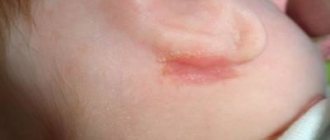What is a fontanel
The fontanelle is a small area located between the bones of the skull, which has not yet had time to ossify. The fontanelles are elements of the “membranous” skeleton.
The anterior (large or frontal, “soft crown”) fontanelle connects the sagittal, frontal and coronal sutures. The shape is diamond-shaped, with four sutures extending from the fontanel itself: frontal, sagittal and two coronal.
Posterior (small or occipital) - has a small depression, this is the point of convergence of the sagittal and lambdoid sutures. The shape of this fontanel is triangular, three sutures extend from it: sagittal and two lambdoid.
There are other fontanelles (paired mastoid and paired sphenoid), but it is the first two that are of great practical importance, so special attention is always paid to them.
Pulsation of the fontanelles is an absolutely normal phenomenon. Despite the fact that there is still no ossification at the site of the fontanel, the connective tissue has sufficient strength to protect the baby from possible injuries.
Normal size of the fontanel
The normal size of the fontanel has its own range, which varies and can be individual for each newborn. However, there are generally accepted dimensions that you can rely on.
Dimensions of a large fontanel:
| Interval | Size |
| 0 -1 month | 25 - 28 mm |
| 1 - 2 month | 25 - 28 mm |
| 2 - 3 month | 23 - 24 mm |
| 3 - 4 month | 20 - 21 mm |
| 4 - 5 month | 18 - 20 mm |
| 5 - 6 month | 18 - 20 mm |
| 6 - 7 month | 16 - 17 mm |
| 7 - 8 month | 16 - 17 mm |
| 8 - 9 month | 14 - 15 mm |
| 9 - 10 month | 12 - 14 mm |
| 10 - 11 month | 9 - 12 mm |
| 11 - 12 month | 5 - 8 mm |
Dimensions of a small fontanel
| Interval | Size |
| 1 - 3 month | 5-7 mm |
The mastoid and sphenoid fontanelles close almost immediately after birth, and in some cases, even during intrauterine development.
Mild dehydration
The main causes of mild dehydration, in which the crown of the head sinks, are insufficient fluid intake into the body and overheating. The table will help you understand how much fluid your child needs:
| Age | Total daily fluid volume, ml/kg |
| 7 days | 90 |
| 8 days – 3 months | 135 |
| 3 – 6 months | 150 |
| 6 – 9 months | 140 |
| 9 – 12 months | 130 |
| 12 – 24 months | 125 |
For example, a baby is 4 months old and weighs 6 kg. This means he needs 900 ml of fluid per day. From this amount you need to subtract the volume of breast milk or formula that the baby receives. As a result, the amount of drink that needs to be given additionally will come out.
It is worth noting that with natural feeding, carried out on demand, the baby, as a rule, does not require additional liquid. With artificial nutrition, drinking is mandatory. The baby should be offered boiled or special baby water.
To prevent dehydration, your child should drink the appropriate amount of fluid for their age.
You can avoid the appearance of a sunken crown due to overheating by observing certain air parameters in the room and dressing the child correctly. Famous pediatrician E.O. Komarovsky advises adhering to the following indicators:
- air temperature – 18-22°C;
- relative humidity – 60-70% (this can be achieved using a household humidifier);
- a minimum number of items that accumulate dust - upholstered furniture, toys, carpets;
- regular wet cleaning;
- frequent through ventilation.
In addition, it is important to dress your child “for the weather.” Due to imperfect thermoregulation, too much wrapping quickly leads to overheating, as a result of which the body loses moisture and the membrane collapses. At a temperature of 20-22°, a cap is not needed, since it covers the fontanelle, through which the body cools. It is important to avoid keeping your baby in direct sunlight.
When does the fontanel heal?
There is no clear answer to this question. The thing is that this process is purely individual; each baby has his own time frame for overgrowing of the fontanelles.
As mentioned above, paired sphenoid and mastoid fontanelles close up soon after birth, and some babies are born with already ossified fontanelles, both options are the norm.
The posterior or small fontanel may heal soon after birth or by three months.
When does a large fontanelle heal in a baby? This question can be answered in more detail. The anterior fontanel is always closely monitored, since its abnormal overgrowth may indicate pathology. But here, too, there are no clear time boundaries, as a rule, the time for a large fontanel to heal is between 10 and 14 months, but sometimes it can ossify by 3 months, or remain open, for example, at 18 months, but the fontanel closes until 2 years.
The specialist evaluates the condition of the fontanel, the physical development and health of the baby as a whole, so it is wrong to think about pathologies based only on the size of the fontanel.
There is an unspoken rule that in children who are breastfed, the fontanelles heal somewhat faster than in babies who are bottle-fed. However, this hypothesis does not have precise confirmation and is based on general statistics.
Which doctor should I contact if my fontanel is retracted?
Mommy should know that a slight collapse of the fontanelle is possible when the child is in an upright position and crying.
This is considered the norm. But, if the fontanel has sunk, its pulsation has increased, the number of urinations has decreased and the baby’s well-being has worsened, this is a reason to contact a pediatrician. If necessary, he will prescribe laboratory and instrumental examinations. The doctor will also decide whether it is necessary to consult a neurologist and an infectious disease specialist.
In principle, parents should always pay attention to the condition of the fontanelles and call a doctor if there are any alarming signs.
What function does the fontanelle perform?
- The fontanelles act as shock absorbers, which are located between the bones of the newborn’s skull and protect the brain from possible injuries.
- The presence of fontanelles contributes to the normal and unhindered passage of the fetal head through the birth canal. The fact is that the fontanelles allow the baby’s head to “fold” and “shrink”, this helps the child to be born without injuries and concussions.
- A large fontanel serves as an indicator of the presence of pathologies. If it is swollen or, conversely, sunken, one may suspect pathology or a developmental disorder.
- The baby’s brain actively grows throughout the first year of life, and the fontanelles help the bones of the skull cope with the load.
- The fontanelle helps to “cool” the brain when the baby’s temperature rises.
- In the first year of life, a child actively gets acquainted with the world; falls and blows are not uncommon. The fontanelle suppresses the force of shaking.
- The fontanel helps assess the physiological development of the child.
Additional recommendations
When receiving a doctor’s recommendation, parents must strictly follow them, since neglect can harm the baby’s health.
It is worth paying attention to changes in the position of the membrane not only when the child is crying, but also in a calm state. Too much of a difference between when it dips and bulges may indicate a health problem. In this case, it is better to consult a doctor. Another reason to visit a doctor is pronounced pulsation of the fontanel. It is likely that the baby is healthy, but it is better to make sure.
It is important to monitor not only whether the fontanel has sunk in or not, but also the rate of its overgrowth. In case of early closure, the baby must be shown to a neurologist to rule out central nervous system pathology. Ossification of the membrane later than expected signals a lack of nutrients, in particular calcium and vitamin D. The pediatrician can prescribe vitamin complexes and also suggest a special scheme for introducing complementary foods. In addition, massage and therapeutic exercises are practiced to prevent problems with the musculoskeletal system.
The fontanelles on a child’s head perform several important functions, including allowing one to assess his well-being. A sunken membrane or its strong pulsation is a reason to consult a pediatrician, even if there are no other signs of trouble. If you have symptoms of severe dehydration, you should immediately consult a doctor, as this condition is very dangerous for young children. In addition, it is worth paying attention to the rate of overgrowth of “soft spots” in order to promptly respond to a deficiency of microelements.
Pediatrician of the 2nd category, allergist-immunologist, graduated from the Belarusian State Medical University of the Federal Agency for Health and Social Development. Read more »
Pathologies of the fontanel
- If the large fontanel closes too early, this may indicate an increase in phosphorus-calcium metabolism.
- Early ossification of the fontanel can affect brain development, interfering with the normal process of brain development.
- Closing too early may indicate that the skull is too small.
- In case of late closure, calcium deficiency may be suspected, which is associated with insufficient intake of vitamin D. In the future, such children may develop rickets.
- If the fontanel closes early, and later episodes of increased intracranial pressure occur, the sutures may diverge.
- If the fontanel has dimensions that significantly exceed the norm, oxygen starvation may be suspected during pregnancy or after birth injuries.
- The following causes of too large fontanelle: metabolic disorders or thyroid function, infectious diseases.
- If the fontanel has a sunken appearance, we can talk about dehydration (the cause of which may be diarrhea or repeated vomiting).
- A bulging fontanelle indicates increased intracranial pressure.
- Deviations in the healing of fontanelles occur in premature babies.
- Constant increased pulsation of the large fontanel is a sign of neurological disorders.
- An enlarged fontanel combined with an excessive increase in the volume of the head indicates hydrocephalus (fluid accumulation).
What to do if a baby’s fontanelle sinks
The retraction of the fontanel is primarily a sign, which can be either due to heat or against the background of a pathological condition.
In extreme heat, a baby with its imperfect thermoregulation and unstable sweating can lose a lot of fluid, so if there are signs of dehydration, it needs to be supplemented.
Pathological fluid loss during illness can be caused by high body temperature, vomiting and loose stools. If diseases with these symptoms are accompanied by retraction of the fontanel, then it is necessary to add supplementary fluids to the main treatment and consult with a pediatrician who can assess the degree of dehydration and calculate the amount of additional fluid the child needs. Severe dehydration may require hospitalization and intravenous fluids.
Every mother should have at least a general idea of the fontanelle in order, firstly, to get rid of unnecessary doubts and fears, and secondly, to be able to independently recognize deviations in the child’s development.
Here is a list of some possible deviations in child development:
1.Protruding fontanel.
If you notice this phenomenon in your baby and there are other symptoms that cause concern, you should immediately call a doctor. Here are the symptoms that should alert you:
- Heat;
- The bulging fontanel was preceded by a head injury to the child;
- Loss of consciousness;
- Vomit;
- Lethargy or, on the contrary, excessive irritability of the child;
- Convulsions or epileptic seizures;
- Strabismus;
But even a bulging fontanel for a long time without any other symptoms is also a sign that something is wrong in the child’s body. This usually occurs due to increased intracranial pressure and is a consequence of serious diseases such as encephalitis, meningitis, various types of tumors or intracranial bleeding. All these diseases are very dangerous and require prompt hospitalization of the child.
2. Sunken fontanel in an infant
This happens mainly due to dehydration of the baby's body. And the reason for dehydration is inappropriate environmental conditions: when the room where the child lives is hot, he breathes dry, warm air and at the same time is wearing a hat, scratches and socks. The first thing you need to do when you discover a sunken fontanelle is to undress the child, ventilate the room and, of course, give the child water to replenish the lack of fluid. And then, be sure to contact your doctor.
3. If a large fontanelle in a baby becomes overgrown very early (literally in the first months of the child’s life), this may indicate such dangerous diseases as microcephaly and craniostenosis
4. Down syndrome
. Together with other signs characteristic of this disease, too large a fontanel size indicates the presence of such a disease.
5. Fontana with rickets.
Rickets
is
the most common cause of late overgrowth of the fontanel. This usually happens in premature babies who have a lack of vitamin D and calcium.
6. Hypothyroidism.
The cause of delayed overgrowth of the fontanel may be a change in thyroid hormones.
All of these deviations in the development of a child are very dangerous and require attention from parents and doctors.











